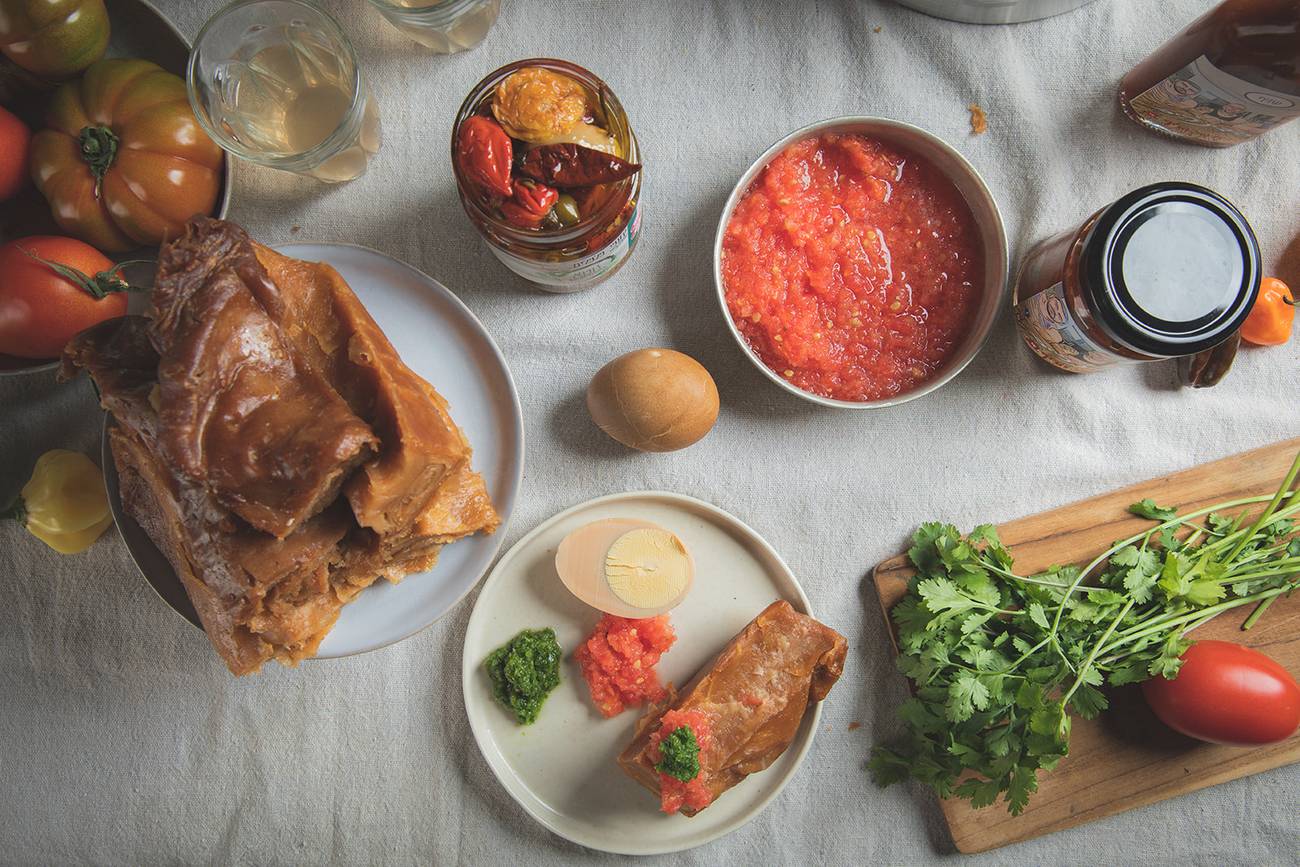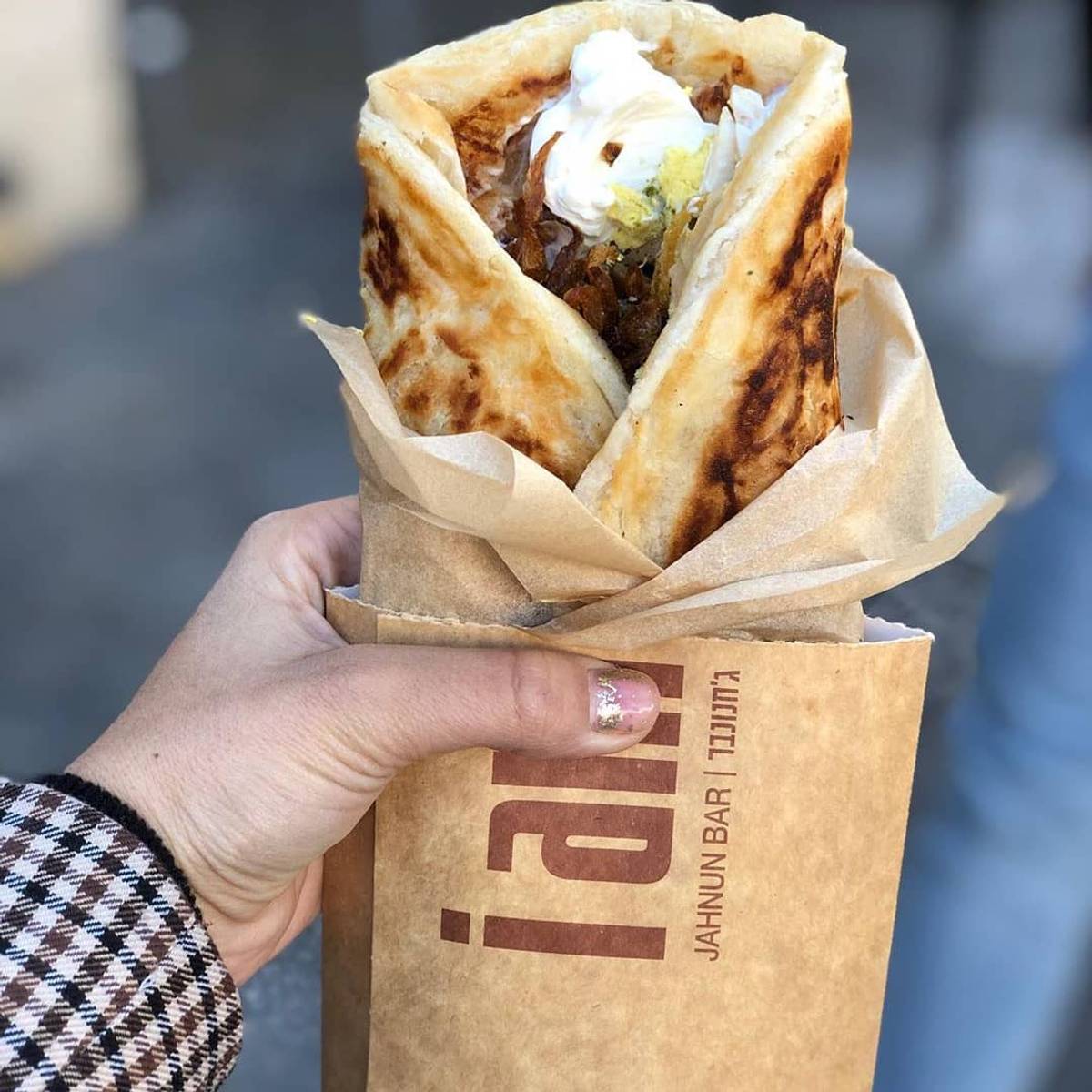The King and Queen of Israeli Pastries
Longtime staples of Jewish-Yemenite cooking, jachnun and malawach have become popular comfort foods across Israel, where their recipes have adapted to local tastes



The Tel Aviv Port Market will, for the first time, honor the king of local pastries: jachnun. For two consecutive weekends—January 19-20 and January 26-27—the plaza outside the market will be filled with stands selling the fresh, handmade treats.
Jachnun is primarily known as a Jewish-Yemenite dish, but—along with malawach, another Jewish-Yemenite pastry—it has been a mainstream Israeli fast-food favorite for decades. They are both perfect comfort foods.
Let’s start with jachnun. It is warm and mildly sweet, and gives you a fuzzy feeling. It could be mistaken for a dessert, but it’s traditionally a Shabbat breakfast food, served in Israel with an oven-baked egg, fresh grated tomato, and zhug (Yemenite hot sauce), which gives it an extra kick.
These days jachnun is consumed all day long—everywhere and anywhere. No Israeli hotel breakfast buffet or school picnic is complete without the commercial version of this log-shaped goodie. Since the rise of foodie culture, some Israelis have recently started making jachnun at home, but for many years, only Yemenite grandmothers would make it from scratch. If the rest of us wanted to consume it at home, we would either buy it frozen or order it as take-out.
You can eat jachnun at most rest stops and many cafes. And on the weekend, jachnun is sold everywhere in Israel: Convenience stores keep a metal container that holds warm jachnun, and kiosks hold a pot of jachnun for clubbers to grab a bite in the early morning hours after a long night out. While traveling across the country it’s not uncommon to see DIY signs, written in a felt-tip pen, informing passersby that jachnun is sold at stands on the side of the road.
Jews in every corner of the world found their own solution for feeding their family on Shabbat while considering religious prohibitions and local supplies. Yemenite Jews from different areas came up with different solutions. Jachnun was the solution of the Jews of the port city of Aden in southern Yemen, where the Jewish community flourished until a deadly pogrom in 1947, which was the beginning of the end of this community. (In 1949-50, many Adeni Jews reached Israel as part of Operation On Eagles’ Wings—also known as Operation Magic Carpet—while the rest relocated to the U.K., and by 1967 there were no Jews left in Aden.)
Adeni Jews used to cook the jachnun overnight (nowadays a “Shabbat hotplate” is used) at a very low temperature and eat it on Saturday after synagogue. Traditionally it took a few days to prepare the dough; it’s a long process with many stages. The gist of it is that the dough is brushed with whatever fat you’re using and folded over again and again to create a layered laminated dough. It is then rolled and slow-cooked in a metal pot with a tight-sealing lid. In Aden, jachnun was made of whole wheat flour and samneh (clarified butter). In Israel, the recipe changed to white flour and margarine; many still use margarine while others use butter or vegan butter. Israelis also add salt and sugar to the dough.
Aden’s port was “Yemen’s gateway to the world,” which explains foreign influences on local cuisine. Indeed, jachnun bears similarity to the Spanish hojaldre puff pastry that Sephardic Jewish exiles might have brought with them to the Ottoman Empire (according to Encyclopedia of Jewish Food by Gil Marks), and to the Turkish yufka dough, which Sephardic Jews’ bourekas are made of.
The original Adeni jachnun was pronounced differently than it is in Israel, tasted different (since the ingredients changed), and was served differently, too—the tomato salsa was added somewhere along the way. Yemenite Jews from other areas of the country didn’t even taste jachnun until they got to Israel. Some even go so far as to say that jachnun is an Israeli invention—a claim that Adeni Jews vehemently deny. Other Jews from various corners of Yemen first encountered jachnun when they found themselves stuck in transit in Aden, on their way to Israel.

Jews started immigrating from Yemen to Palestine in the 19th century. Immigration continued in the 20th century, and since the ruling imam wouldn’t allow Jews to immigrate to Israel, they had to travel first to Aden, which was a British protectorate, and travel onward from there. In May 1945, Yemen closed its doors and didn’t let the Jews leave anymore, which meant that many Jewish families that had already left their homes to immigrate to Israel got stuck in Aden. American Jewish relief organization the Joint Distribution Committee built a refugee camp called Hashed, where thousands of Jews stayed for about three years, until they could finally leave for Israel. This is where many Yemenite Jews first tasted jachnun. This is also where they learned to use wheat flour like the Adeni Jews, according to Moshe David in his book, Disappearing Flavors of the South.
Aden was under British rule from 1839 to 1967 and being a port city, wheat flour was much more available there than in other parts of Yemen. Outside Aden, wheat flour was scarce and expensive, so Yemenite Jews baked with different kinds of sorghum, and also with millet. Independent food researcher Nir Wollman stressed how significant the change from sorghum to wheat flour was on a symbolic level: “In the Arab world, rich people used wheat,” Wollman told me. “Wheat symbolized power and it was the most revered grain in Arab culture, so whoever had money to buy wheat used it to make baked goods that otherwise would have been made out of other kinds of cheaper grains.”
So, wheat flour was used whenever it could be found and afforded. Often pastries would be made with cheaper flour on weekdays and with wheat on Shabbat. Kubaneh, for instance—which, like jachnun, is a Shabbat bread, originating from a different area—was made from cheap kinds of flour during the week and from wheat flour for Shabbat.
When Yemenite Jews from all over Yemen came to Israel, many of them were already using wheat, while others started using it in Israel, since the sorghum they’d used to bake in Yemen was used to feed chickens in Israel. So, it came to be that Yemenite cuisine in Israel is commonly associated with wheat flour pastries, while in actuality most Yemenite Jews rarely used wheat flour in Yemen.
“I know today that jachnun originated in Aden, but my mother wasn’t from Aden, and she used to make jachnun,” I heard from Nava Mazari, expert jachnun maker, who sells jachnun and many other Yemenite specialties, from zhug and fenugreek dip to lahoh and kubaneh, from her home in Kfar Yavetz, a moshav in central Israel. About three years ago, Mazari opened the Facebook page Delicacies of the Yemenite Kitchen, where she shares her recipes—except for her jachnun recipe, which is top secret.
Mazari’s parents immigrated from Yemen in 1949 from areas near Sanaa, Yemen’s capital, and her mother worked as a cook in Israel. “I regret not writing down all of my mother’s recipes while she was still alive,” Mazari told me. “But over the years I’ve perfected my own recipes to reach the exact tastes and smells I remember from her kitchen growing up. Today whoever makes jachnun, malawach, kubaneh, or lahoh makes them a little different—there are many different recipes going around. Plus, nowadays we have ingredients they didn’t have in Yemen or in the early years of the country. We have ingredients that make life easier.”
If jachnun is the king Israeli comfort foods, malawach is surely its queen. There is nothing easier than stocking up your freezer with supermarket-bought frozen malawach. Frying a frozen malawach in a pan is so simple and satisfying that it is often the first meal Israeli teenagers make for themselves.
The origins of malawach are less clear and not as widely discussed as jachnun. Its dough is made with the same ingredients as the jachnun dough (although quantities sometimes differ) but it is pan-fried. While jachnun is cylinder-shaped, malawach is round and flat. While jachnun is brown, greasy, hearty, and heavy, with a sweet caramelized flavor, malawach is rich and chewy but less sweet and somewhat lighter. And it is flaky and golden in color.
In Israel, both are often consumed with a hard-boiled egg, grated tomato, and zhug, but people tend to be looser regarding malawach. Many spread labaneh, cream cheese, honey, or Nutella on it, and since it is flat it can be rolled and used as a wrap.
This lax approach to consuming malawach might stem from the fast-food chain Nargila (meaning hookah), which popularized jachnun and malawach as fast-food staples in Israel in the 1980s and ’90s. The Nargila chain was known for inventing a dish called Ziva—a rolled up malawach filled with cheese, named after the owner’s girlfriend and head waitress—as well as for its provocative menus, which included dirty pictures.
The Nargila restaurants are no more. Nowadays, the go-to for the full Israeli experience of jachnun, malawach, and loud atmosphere, is the Jahnun Bar in Jerusalem’s Machaneh Yehudah Market. Regev Eibenschutz and Yariv Guri first opened the Jahnun Bar on Jerusalem’s Hillel Street 21 years ago. Neither of them is Yemenite, but they had a passion for jachnun and malawach.
The original branch has since closed, but their flagship restaurant in Machaneh Yehudah Market is a popular tourist destination. “Some American Jews that visit Israel try to book a table months in advance, not knowing that this is a street food stand,” Eibenschutz told me with a hearty laugh. The Jahnun Bar also has a branch in the city of Modi’in, and they are on their way to opening more in Tel Aviv—and in Amsterdam, hoping to eventually conquer the rest of Europe.
In addition to standard jachnun and malawach, they serve jachnun and malawach wraps, filled with anything from fried onion and eggplant to various cheeses, hummus, mushrooms, and even shakshuka. If you visit the market on a culinary tour, the guide is sure to stop there and get a malawach with plenty of toppings, sliced like a pizza, to go round for everybody.
The Jahnun Bar is an energetic and noisy place in an über-Israeli sort of way, and when it’s time to turn the malawach in the pan to the other side, they throw it high in the air in front of the customers’ astonished eyes, where the fried dough disc acrobatically performs several somersaults. “This holds no purpose,” Eibenschutz admitted. “It’s strictly for the show and we only do it in Machaneh Yehudah.”
While jachnun and malawach reached fast-food staple status a long time ago, there are many other Jewish-Yemenite pastries that aren’t quite there yet. But still, most Israelis are familiar with at least some of them. if you dig just a little bit deeper and visit a Yemenite eatery in Kerem HaTeimanim or Hatikva Quarter—Tel Aviv neighborhoods where many Yemenites settled—or any other Yemenite area in the country, you can sample saluf (traditional Yemenite flatbread), lahoh (a spongy, pancakelike bread made from a fermented batter, similar to injera, the staple flatbread of Ethiopia and Eritrea, which are very close to Yemen), sabaya (crispy Yemeni layer cake), kubaneh, and more.
Even though Jewish-Yemenite cuisine is diverse and includes soups and meat and vegetable dishes, in Israel, Yemenite food is usually shorthand for pastries—a fact that descendants of the community often resent. To them, reducing Jewish-Yemenite cuisine to dough is a crime, but Israelis love those pastries, especially the ones that were richer to begin with, and adapted to Western tastes over time. This means they are sweeter and less nutritious than they used to be, but no one can deny that they are delicious.
Dana Kessler has written for Maariv, Haaretz, Yediot Aharonot, and other Israeli publications. She is based in Tel Aviv.